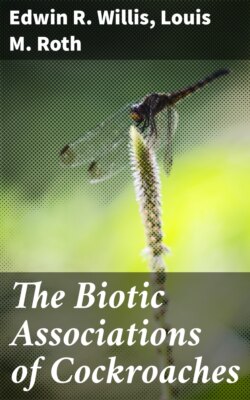Читать книгу The Biotic Associations of Cockroaches - Edwin R. Willis - Страница 7
На сайте Литреса книга снята с продажи.
HISTORICAL
ОглавлениеTable of Contents
Chopard (1938) in his book La Biologie des Orthoptères reviewed much of the literature on cockroaches, but of the many biotic associations that exist he discussed only the commensal cockroaches, gregariousness, and familial associations. Asano (1937), who reviewed the natural enemies of cockroaches, mentioned about 10 groups of animals that attack cockroaches. Thompson (1951) in his Parasite Host Catalogue, which was based mainly on papers abstracted or noted in the Review of Applied Entomology, listed only 19 insect parasites of cockroaches. Eighteen of these were Hymenoptera which attack only cockroach eggs; the single dipteron listed (Sarcophaga lambens Wiedemann, supposedly parasitic on Pycnoscelus surinamensis) is not a parasite in this case, but deposits its eggs on the dead insects (see p. 229). Cameron (1955) listed as parasites and predators of the cockroach 24 species of hymenopterous egg parasites, 7 species of Ampulex which hunt nymphs and adults, 17 Protozoa, 13 nematodes, 5 bacteria, 2 mites, and a few other miscellaneous predators. In his classified list of the protozoan parasites of the Orthoptera of the world, Semans (1943) listed about 26 species from cockroaches. Linstow (1878, 1889) recorded 14 species of helminths from cockroaches. Van Zwaluwenburg (1928) listed 33 names of roundworms which are commensals or secondary parasites of cockroaches, but some of these names are synonyms. La Rivers (1949) extended this list with 13 additional species. Chitwood (1932) recognized 24 species of nematodes which are primary parasites (probably commensals) of blattids. Steinhaus (1946) gave many instances of biological relationships between cockroaches and bacteria, fungi, and yeasts, but the cockroaches were not discussed as an entity and the information is scattered throughout the book.
In surveying the literature on this subject we have collected a far more extensive list of animals and plants associated with cockroaches than one might have expected from an examination of any one of the previous papers on this subject. In our review of the medically important organisms associated with the Blattaria, we pointed out that in addition to many experimental associations cockroaches have been found to harbor, naturally, 4 strains of poliomyelitis virus, about 40 species of pathogenic bacteria, the eggs of 7 species of pathogenic helminths, and to serve as intermediate hosts of 12 other species of helminths pathogenic for vertebrates; cockroaches have also been found to carry, on occasion, 3 species of Protozoa that are pathogenic to man and 2 species of fungi which are sometimes found associated with pathological conditions.
In addition to the above organisms of medical importance, we have compiled records of other organisms, nonpathogenic to vertebrates, which are naturally associated in some way with cockroaches. None of the following numbers can be considered absolute because some names may be synonyms. However, we believe that these figures are very close to the actual numbers of species that have been isolated because we have attempted to refer all obvious synonyms to the currently accepted name for each organism. On this basis there are about 45 species of bacteria, 40 fungi, 6 yeasts, 90 Protozoa, and 45 helminths that have been found associated naturally with cockroaches. Of the arthropods there are about 2 species of scorpions, 4 spiders, 15 mites, 4 centipedes, and 90 insects. Of vertebrates there are 4 species of fish, 16 amphibians, 12 reptiles, 20 birds, and 27 mammals. Besides these there are many records of experimental associations that have been contrived in the laboratory.
Some idea of the increase in our knowledge of the biotic associations of cockroaches, during the last 70 years, may be gathered from a comparison of the above figures with those of Miall and Denny (1886) who presented " ... a long list of parasites which infest the Cockroach." This list included 2 bacteria, 6 Protozoa (some of the names are synonyms), 7 nematodes (some of these names are also synonyms), 1 mite, 1 wasp, and 1 beetle. In addition, they mentioned as other foes of the cockroach: monkeys, hedgehogs, polecats, cats, rats, birds, chameleons, and frogs.
